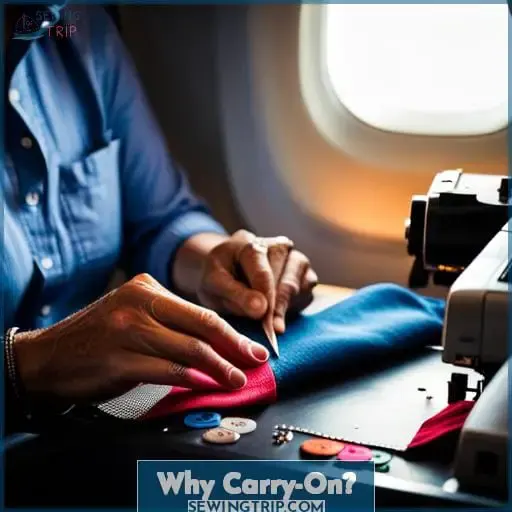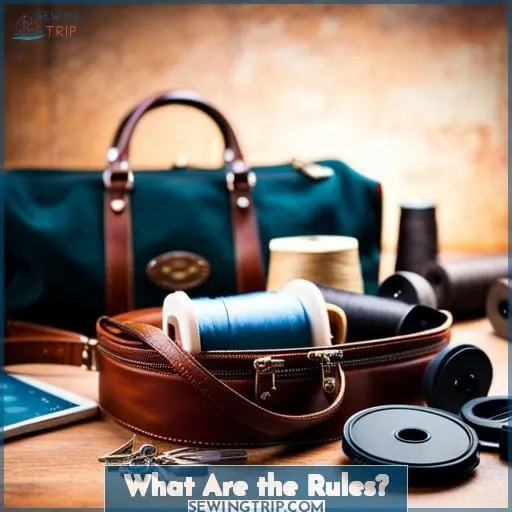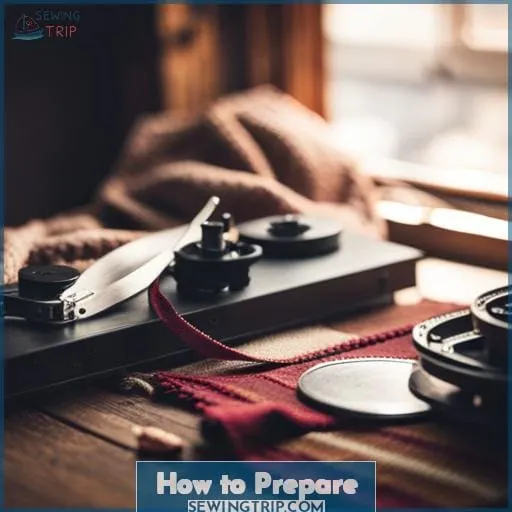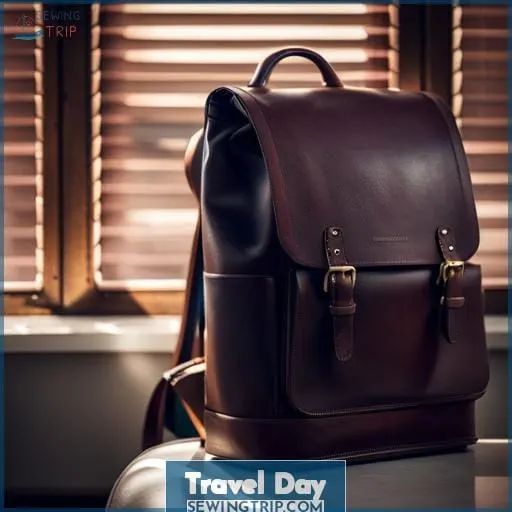This site is supported by our readers. We may earn a commission, at no cost to you, if you purchase through links.
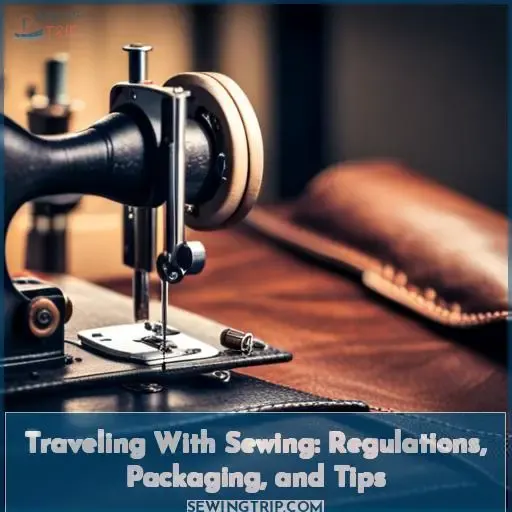 Imagine jetting off to your dream destination, sewing machine in tow. Whether you’re a seasoned traveler or just starting out, navigating the world with your beloved sewing gear can be a breeze.
Imagine jetting off to your dream destination, sewing machine in tow. Whether you’re a seasoned traveler or just starting out, navigating the world with your beloved sewing gear can be a breeze.
In this article, we’ll explore the regulations and restrictions when traveling with sewing equipment, discuss packaging and preparation tips for seamless journeys, and delve into why carrying on is often the best choice.
Get ready to embark on an adventure where creativity meets wanderlust!
Table Of Contents
Key Takeaways
- Comply with travel providers’ regulations and restrictions, as well as TSA guidelines for packaging and carrying scissors and sharp objects.
- Consider baggage considerations and security measures when deciding between carry-on and checked baggage.
- Utilize waterproofing techniques and compact travel sewing machines within carry-on limits for efficient packing and preparation.
- Prioritize safety measures by securely storing needles, stabilizing sewing machines, and removing excess weight from storage drawers.
Traveling With a Sewing Machine
When it comes to traveling with a sewing machine, there are important regulations and restrictions to be aware of.
Understanding whether you can carry your machine on as carry-on or if you need to check it, along with the packaging and preparation required, is crucial for a smooth journey.
Let’s delve into the details of these points so that you can confidently travel with your beloved sewing machine.
Regulations and Restrictions
When traveling with a sewing machine, it’s important to be aware of and comply with the regulations and restrictions set by travel providers.
Ensure needle security and protect fragile equipment by using a sewing machine travel bag or portable alternatives.
Make sure your packaging meets TSA compliance guidelines, including waterproofing techniques if necessary.
Following these regulations will ensure a smooth journey for both you and your beloved sewing machine.
Carry-on Vs Checked Baggage
If you’re traveling with a sewing machine, deciding whether to carry it on or check it as baggage can be an important consideration. Baggage considerations and security measures play a role in this decision-making process.
While carrying your sewing machine on board provides personal oversight and ensures its safety, there may be size and weight restrictions that need to be considered.
Portable options like compact travel sewing machines or waterproof models can also make the choice easier.
Additionally, shipping challenges should also be taken into account when determining how best to transport your sewing machine during travel.
Packaging and Preparation
To ensure the safe travel of your sewing machine, proper packaging and preparation are essential.
- Waterproofing Techniques: Wrap your machine in plastic bags for protection against liquid accidents.
- Portable Machine Options: Consider investing in a compact travel sewing machine that fits within carry-on weight limits.
- TSA Regulations: Be aware of the rules regarding scissors and other sharp objects when traveling with sewing tools.
- Sewing Essentials: Pack all necessary needles, thread, and other essentials for on-the-go crafting adventures.
Why Carry-On?
When traveling with your sewing machine, carrying it on as a carry-on item provides you with personal oversight and care.
By keeping your machine close to you, you can prevent potential mishandling such as tossing, rolling, or dropping that may occur if checked in baggage.
Additionally, opting for carry-on ensures that your valuable sewing machine is treated with the utmost care throughout its journey and minimizes the risk of damage that could occur in checked baggage.
Personal Oversight and Care
To ensure the safety and protection of your sewing machine, it’s essential to carry it on with you during your travels. Personal supervision ensures careful handling and machine security throughout the journey.
By carrying it on, you can avoid potential mishandling and damage that may occur if checked as baggage.
Plus, having your sewing machine within reach provides travel convenience for any unexpected moments of inspiration or creative bursts while away from home.
Potential Damage in Checked Baggage
Choose carry-on for your sewing machine to avoid potential damage in checked baggage.
When you check your machine, it faces risks such as tossing, rolling, and dropping that can lead to costly repairs or irreparable damage. Even with fragile labeling and handling precautions, the handling process during baggage transfer is unpredictable.
By keeping your sewing machine close in a carry-on bag, you have personal oversight throughout the journey and ensure its safe arrival at your destination.
What Are the Rules?
When it comes to traveling with your sewing machine, there are certain rules and regulations that you need to be aware of.
One important aspect is the size and weight restrictions imposed by travel providers. While domestic sewing machines usually fit within size limits, weight limits may vary, so it’s crucial to check with your airline beforehand.
Size and Weight Restrictions
Check with your airline for the size and weight restrictions on carrying sewing machines as baggage.
When traveling abroad, it’s important to know the rules to ensure a smooth journey with your sewing machine. Compact machines are often preferred due to their portability, but be aware of weight limits that may vary between airlines.
Remember that fragile items require extra care when packing and consider portable options or shipping considerations if necessary.
Considerations for Domestic Sewing Machines
Make sure you familiarize yourself with the rules and regulations for traveling with your domestic sewing machine.
When considering taking your sewing machine on a trip, there are several important factors to keep in mind:
- Domestic Machine Considerations: Understand the specific requirements and limitations for bringing a domestic sewing machine on board.
- Weight Limitations: Check the weight restrictions imposed by airlines to ensure compliance.
- Packaging Innovations: Explore compact travel options or packaging innovations designed specifically for transporting sewing machines.
With these considerations in mind, you can confidently embark on your journey while keeping your passion for sewing alive.
How to Prepare
Now that you’ve learned about the regulations and rules for traveling with your sewing machine, it’s time to discuss how to prepare for your journey.
Making adjustments such as:
- Removing the needle and storing it safely
- Putting down the foot for added stability
- Removing excess weight from storage drawers
are important steps in ensuring a smooth travel experience.
Additionally, considering packaging options like:
- Utilizing the original box
- Investing in a sewing machine travel bag
can provide extra protection during transit.
Adjustments and Safety Measures
To ensure a smooth journey, it’s important to make necessary adjustments and take safety measures when preparing to travel with your sewing machine.
| Adjustment Techniques | Safety Measures | Packing Efficiency |
|---|---|---|
| Remove needle | Pack accessories separately | Utilize original packaging or travel bag |
- Store foot pedal and cord separately in baggage
- Securely pack small scissors in checked baggage
- Wrap the sewing machine in plastic bags for coverage
These simple adjustments and safety measures will help protect your sewing machine during travel while ensuring packing efficiency.
Packing and Organization Tips
Pack your sewing machine travel bag with essential items to ensure a smooth and organized journey.
- Opt for portable storage solutions that maximize space and keep everything secure.
- Use efficient packing techniques like rolling clothing or using compression bags to save room.
- Incorporate organization hacks such as labeling compartments or using small containers for accessories.
- Choose compact accessories that are travel-friendly, lightweight, and durable for hassle-free sewing on the go.
Travel Day
On travel day, it’s important to pack your sewing tools and accessories carefully.
Make sure to consider the size and weight restrictions for trolleys or luggage that you plan to use.
If you have any questions or concerns, don’t hesitate to seek advice from customer service regarding suitable travel accessories for your sewing needs.
Packing Sewing Tools and Accessories
Don’t forget to pack your essential sewing tools and accessories for travel day.
Ensure you have proper thread storage to keep everything organized and tangle-free.
Remember to bring along your favorite essential notions, such as scissors, needles, and a thimble.
Consider using a dedicated sewing bag that’s designed for on-the-go sewing.
Invest in travel-friendly tools that are compact yet efficient to make your traveling with sewing experience hassle-free.
Considerations for Trolleys or Luggage
When traveling with your sewing machine, consider the weight limits of trolleys or luggage to ensure you don’t exceed airline restrictions.
Look for luggage options that are lightweight and have features like wheels, pockets, and padded straps for easy transport.
Consider investing in a portable sewing machine that’s compact and lightweight to make traveling even more convenient.
Pack your accessories carefully to maximize space and stay within weight limits while keeping everything organized during your journey.
Seek Advice From Customer Service for Travel Accessories
Before your travel day, make sure to seek advice from customer service about suitable travel accessories for your sewing machine journey.
They can provide guidance on customized travel gear and accessory innovations that will ensure the safe transportation of your machine.
Expert packing tips and specialized gear recommendations are also available to help you prepare for a hassle-free trip.
Take advantage of their customer guidance to find the perfect sewing bag with features like zip pouches for organizing thread and other essentials.
Frequently Asked Questions (FAQs)
Can I bring sewing scissors in my carry-on bag?
Yes, you can bring sewing scissors in your carry-on bag.
Make sure they’re under 4 inches from the pivot and have a non-sharp tip.
These essential tools for your sewing projects can accompany you on your journey to creative freedom.
What are some alternatives to flying with a sewing machine?
Consider shipping your sewing machine if flying isn’t feasible. While it may involve some packaging challenges and potential costs, this alternative ensures convenience and minimizes the risk of damage or loss during transit.
Are there any restrictions on bringing sewing machine needles on a plane?
When it comes to bringing sewing machine needles on a plane, remember the saying better safe than sorry.
Check with TSA regulations to ensure you adhere to their guidelines for hassle-free travel.
How do I pack my sewing machine in a travel bag?
To pack your sewing machine in a travel bag, first remove any attachments and accessories.
Securely wrap the machine in plastic bags for waterproofing.
Utilize the original packaging or tightly pack it with towels for protection.
Can I bring a portable sewing machine as a carry-on item?
Absolutely! Bringing a portable sewing machine as carry-on allows you the freedom and control to protect your precious tool. Feel empowered with your creative companion by your side, ready for any sewing adventure that awaits.
Conclusion
Embark on your sewing adventure with confidence as you travel to your dream destination. By following regulations, packaging your sewing gear carefully, and opting for carry-on, you can ensure a seamless journey.
Seek advice from customer service for any additional travel accessories you may need.


